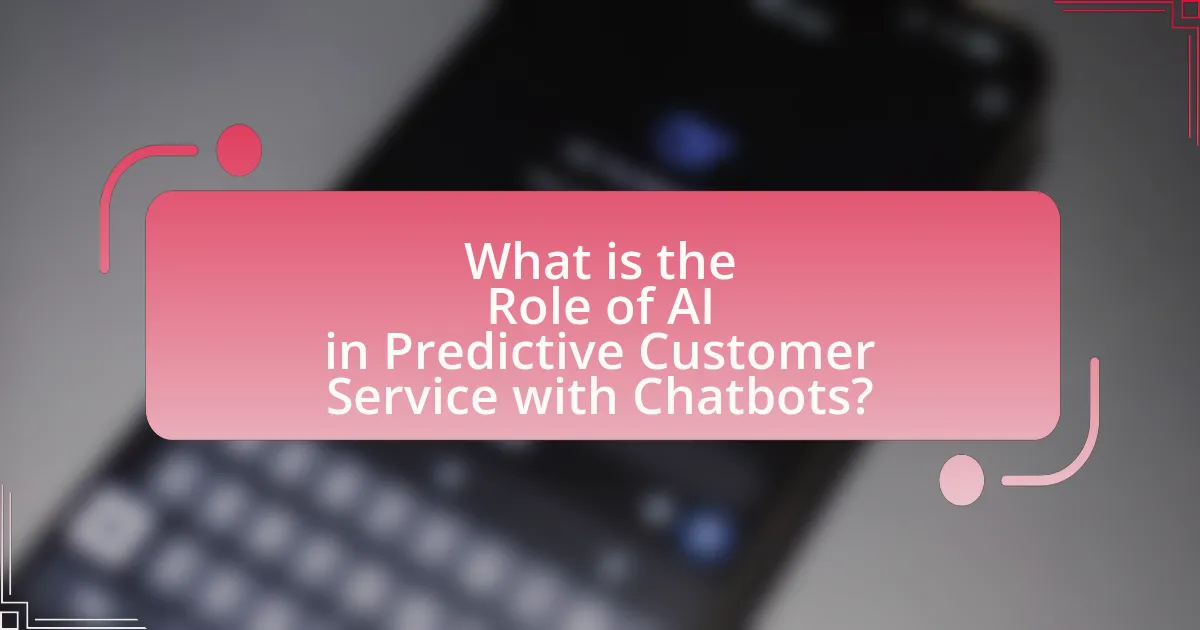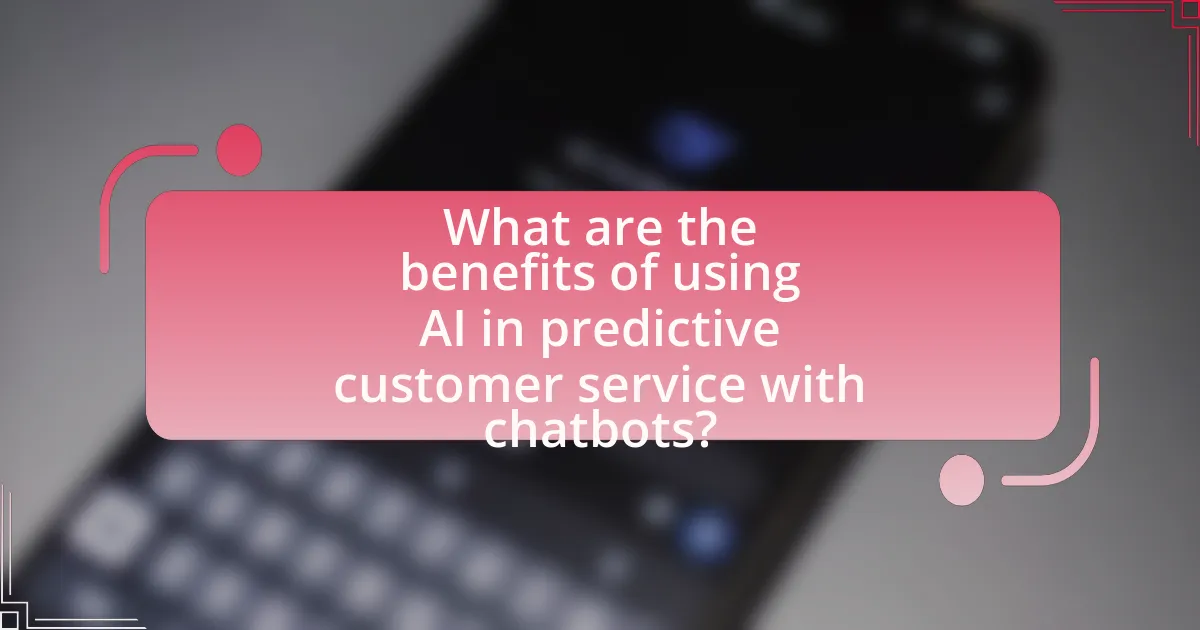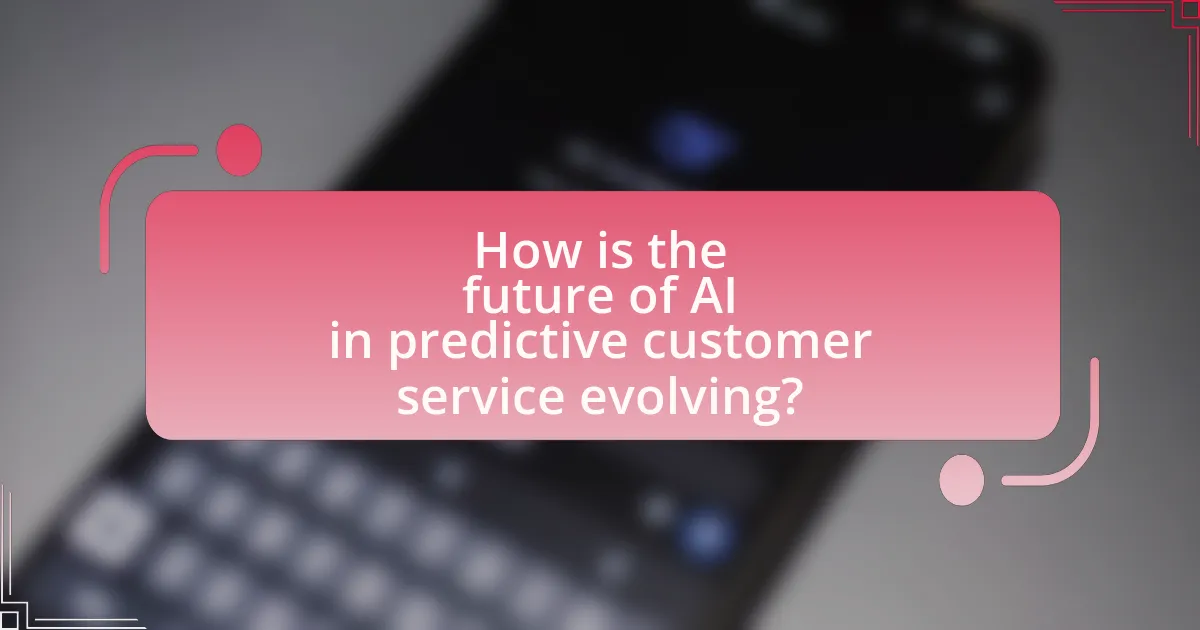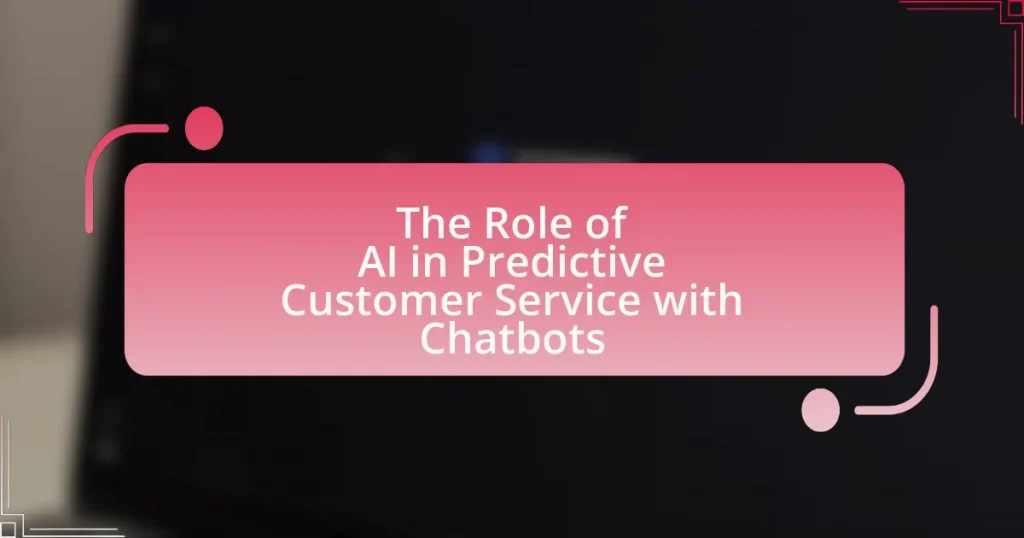The article focuses on the role of artificial intelligence (AI) in predictive customer service through chatbots. It highlights how AI enables chatbots to analyze customer data, anticipate needs, and provide personalized support, leading to improved customer satisfaction and operational efficiency. Key topics include the algorithms used in AI for predictive capabilities, the features of chatbots that enhance customer interactions, and the challenges faced in implementing AI technologies. Additionally, the article discusses best practices for optimizing chatbot performance, measuring success, and the future trends shaping AI in customer service.

What is the Role of AI in Predictive Customer Service with Chatbots?
AI plays a crucial role in predictive customer service with chatbots by enabling them to analyze customer data and anticipate needs. This capability allows chatbots to provide personalized responses and proactive support, enhancing customer satisfaction. For instance, AI algorithms can process historical interaction data to identify patterns, enabling chatbots to predict potential issues before they arise. Research indicates that companies utilizing AI-driven chatbots can improve response times by up to 80%, demonstrating the effectiveness of AI in streamlining customer service operations.
How does AI enhance predictive capabilities in customer service?
AI enhances predictive capabilities in customer service by analyzing vast amounts of customer data to identify patterns and trends. This data-driven approach allows AI systems to anticipate customer needs, predict potential issues, and recommend solutions before problems escalate. For instance, AI can analyze historical interaction data to forecast peak service times, enabling businesses to allocate resources more effectively. Additionally, a study by McKinsey & Company found that companies using AI for customer service can improve response times by up to 30%, demonstrating the tangible benefits of predictive analytics in enhancing customer experiences.
What algorithms are commonly used in AI for predictive customer service?
Common algorithms used in AI for predictive customer service include decision trees, random forests, support vector machines, and neural networks. These algorithms analyze historical customer data to identify patterns and predict future behaviors, enabling businesses to anticipate customer needs and improve service efficiency. For instance, decision trees provide a clear model for decision-making based on customer attributes, while neural networks can capture complex relationships in large datasets, enhancing predictive accuracy.
How do these algorithms improve customer interactions?
Algorithms improve customer interactions by enabling personalized and efficient communication through chatbots. These algorithms analyze customer data and behavior patterns to tailor responses and recommendations, enhancing user experience. For instance, a study by McKinsey found that companies using AI-driven chatbots can improve customer satisfaction by up to 20% due to faster response times and more relevant interactions. Additionally, algorithms facilitate 24/7 support, allowing customers to receive assistance anytime, which further increases engagement and satisfaction.
What are the key features of chatbots in predictive customer service?
The key features of chatbots in predictive customer service include natural language processing, proactive engagement, data analysis capabilities, and integration with customer relationship management systems. Natural language processing enables chatbots to understand and respond to customer inquiries in a conversational manner, enhancing user experience. Proactive engagement allows chatbots to anticipate customer needs based on historical data and behavior patterns, facilitating timely assistance. Data analysis capabilities empower chatbots to analyze customer interactions and feedback, leading to improved service and personalized recommendations. Integration with customer relationship management systems ensures that chatbots have access to relevant customer information, enabling them to provide tailored support and solutions. These features collectively enhance the efficiency and effectiveness of customer service operations.
How do chatbots utilize AI for personalized customer experiences?
Chatbots utilize AI to create personalized customer experiences by analyzing user data and interactions to tailor responses and recommendations. Through natural language processing (NLP) and machine learning algorithms, chatbots can understand customer preferences, past behaviors, and specific inquiries, allowing them to provide relevant information and solutions. For instance, a study by Salesforce found that 69% of consumers prefer chatbots for quick communication with brands, highlighting the effectiveness of AI in enhancing customer engagement. By leveraging these technologies, chatbots can adapt their conversational style and content to meet individual customer needs, ultimately improving satisfaction and loyalty.
What role does natural language processing play in chatbot effectiveness?
Natural language processing (NLP) is crucial for enhancing chatbot effectiveness by enabling them to understand and respond to human language accurately. NLP allows chatbots to interpret user queries, extract intent, and generate relevant responses, which significantly improves user interaction quality. For instance, a study by IBM found that chatbots utilizing NLP can achieve up to 90% accuracy in understanding user intents, leading to higher customer satisfaction and engagement rates. This capability to process and analyze language data in real-time is essential for chatbots to provide timely and contextually appropriate responses, thereby optimizing the overall customer service experience.
What challenges does AI face in predictive customer service with chatbots?
AI faces several challenges in predictive customer service with chatbots, primarily including data quality, natural language understanding, and integration with existing systems. Data quality issues arise when chatbots are trained on incomplete or biased datasets, leading to inaccurate predictions and responses. Natural language understanding is a significant hurdle, as chatbots often struggle to comprehend context, nuances, and variations in human language, which can result in miscommunication. Additionally, integration challenges occur when chatbots need to work seamlessly with various customer relationship management (CRM) systems and databases, which can complicate the implementation process and hinder their effectiveness. These challenges collectively impact the reliability and efficiency of AI-driven predictive customer service solutions.
How do data privacy concerns impact the use of AI in customer service?
Data privacy concerns significantly limit the deployment of AI in customer service by necessitating stricter compliance with regulations such as GDPR and CCPA. These regulations require organizations to ensure that customer data is collected, stored, and processed transparently and securely, which can complicate the integration of AI technologies that rely on large datasets for training and operation. For instance, a survey by PwC found that 85% of consumers will not do business with a company if they have concerns about its data privacy practices. This apprehension can lead to reduced customer engagement and trust, ultimately hindering the effectiveness of AI-driven customer service solutions.
What are the limitations of current AI technologies in this field?
Current AI technologies in predictive customer service with chatbots face several limitations, including a lack of contextual understanding, inability to handle complex queries, and challenges in emotional intelligence. These limitations hinder the effectiveness of chatbots in providing accurate and personalized customer interactions. For instance, many chatbots struggle to comprehend nuanced language or context-specific inquiries, leading to misinterpretations and unsatisfactory responses. Additionally, while advancements in natural language processing have improved chatbot capabilities, they still fall short in recognizing and responding to emotional cues, which can negatively impact customer satisfaction. According to a study by Gartner, by 2025, 75% of customer service interactions will be powered by AI, yet only 20% of organizations will achieve a high level of customer satisfaction with these technologies, highlighting the ongoing challenges in this field.
How can businesses implement AI-driven chatbots for predictive customer service?
Businesses can implement AI-driven chatbots for predictive customer service by integrating machine learning algorithms that analyze customer data to anticipate needs and preferences. This involves collecting historical interaction data, utilizing natural language processing to understand customer inquiries, and deploying predictive analytics to forecast future customer behavior. For instance, a study by McKinsey found that companies using AI chatbots can improve customer satisfaction by up to 20% through personalized interactions. By continuously training the chatbot with new data, businesses can enhance its predictive capabilities, ensuring timely and relevant responses to customer queries.
What are the best practices for optimizing chatbot performance?
The best practices for optimizing chatbot performance include continuous training, user feedback integration, and context awareness. Continuous training ensures that the chatbot learns from interactions, improving its ability to understand and respond accurately. User feedback integration allows for real-time adjustments based on customer experiences, enhancing satisfaction and effectiveness. Context awareness enables the chatbot to provide relevant responses based on previous interactions and user data, leading to a more personalized experience. Research indicates that chatbots utilizing these practices can achieve up to a 70% increase in user satisfaction and engagement, demonstrating their effectiveness in predictive customer service.
How can businesses measure the success of AI in their customer service strategy?
Businesses can measure the success of AI in their customer service strategy through key performance indicators (KPIs) such as customer satisfaction scores, response time, and resolution rates. For instance, tracking customer satisfaction through surveys can provide direct feedback on the effectiveness of AI interactions, while analyzing average response times can reveal improvements in efficiency. Additionally, monitoring first contact resolution rates can indicate how well AI resolves issues without human intervention. According to a study by McKinsey, companies that effectively implement AI in customer service can see a 20-30% increase in customer satisfaction and a significant reduction in operational costs, validating the importance of these metrics in assessing AI success.
What common pitfalls should businesses avoid when deploying chatbots?
Businesses should avoid several common pitfalls when deploying chatbots, including inadequate training data, lack of clear objectives, and poor user experience design. Inadequate training data can lead to chatbots that fail to understand user queries effectively, resulting in frustration and disengagement. A lack of clear objectives can cause chatbots to operate without purpose, leading to inefficient interactions that do not meet customer needs. Additionally, poor user experience design, such as overly complex interfaces or failure to provide human escalation options, can deter users from utilizing the chatbot. These pitfalls can significantly undermine the effectiveness of chatbots in enhancing predictive customer service.

What are the benefits of using AI in predictive customer service with chatbots?
AI in predictive customer service with chatbots enhances efficiency, improves customer satisfaction, and reduces operational costs. By analyzing customer data and interactions, AI can anticipate customer needs, enabling chatbots to provide timely and relevant responses. For instance, a study by McKinsey found that businesses using AI-driven chatbots can reduce customer service costs by up to 30%. Additionally, AI chatbots can operate 24/7, ensuring that customers receive support at any time, which significantly boosts customer experience and loyalty.
How does AI improve customer satisfaction and loyalty?
AI improves customer satisfaction and loyalty by providing personalized experiences and efficient service through chatbots. These AI-driven systems analyze customer data to tailor interactions, ensuring that responses are relevant and timely. For instance, a study by McKinsey found that companies using AI for customer service can increase customer satisfaction scores by up to 20%. Additionally, chatbots can handle inquiries 24/7, reducing wait times and enhancing the overall customer experience. This immediate access to support fosters loyalty, as customers appreciate quick resolutions and personalized attention.
What metrics indicate enhanced customer satisfaction through AI chatbots?
Metrics indicating enhanced customer satisfaction through AI chatbots include customer satisfaction score (CSAT), net promoter score (NPS), first response time (FRT), and resolution rate. CSAT measures the percentage of customers who are satisfied with their interaction, often reflecting immediate feedback after a conversation. NPS gauges customer loyalty by asking how likely customers are to recommend the service, providing insight into overall satisfaction. FRT tracks the time taken for the chatbot to respond to customer inquiries, with shorter times correlating to higher satisfaction. Resolution rate indicates the percentage of inquiries successfully resolved by the chatbot, with higher rates signifying effective service. These metrics collectively provide a comprehensive view of customer satisfaction levels associated with AI chatbot interactions.
How can predictive analytics lead to proactive customer service?
Predictive analytics can lead to proactive customer service by enabling businesses to anticipate customer needs and behaviors before they arise. By analyzing historical data and identifying patterns, companies can predict potential issues, such as service disruptions or customer dissatisfaction, allowing them to address these concerns proactively. For instance, a study by McKinsey found that organizations using predictive analytics can improve customer satisfaction scores by up to 20% by resolving issues before customers even notice them. This proactive approach not only enhances the customer experience but also reduces operational costs associated with reactive service measures.
What cost savings can businesses expect from AI-driven chatbots?
Businesses can expect significant cost savings from AI-driven chatbots, primarily through reduced operational expenses and increased efficiency. For instance, AI chatbots can handle up to 80% of routine customer inquiries without human intervention, which can lead to a reduction in customer service staffing costs. According to a report by Juniper Research, businesses could save over $8 billion annually by 2022 through the implementation of chatbots in customer service roles. Additionally, AI chatbots can operate 24/7, eliminating the need for overtime pay and allowing companies to allocate resources more effectively. This efficiency not only lowers costs but also enhances customer satisfaction, leading to potential revenue growth.
How do chatbots reduce operational costs in customer service?
Chatbots reduce operational costs in customer service by automating routine inquiries and tasks, which decreases the need for human agents. By handling a high volume of customer interactions simultaneously, chatbots can resolve issues such as FAQs, order tracking, and basic troubleshooting without human intervention. According to a study by Juniper Research, chatbots are expected to save businesses over $8 billion annually by 2024 through improved efficiency and reduced labor costs. This automation allows companies to allocate resources more effectively, focusing human agents on complex issues that require personal attention.
What is the return on investment for implementing AI chatbots?
The return on investment for implementing AI chatbots can be substantial, with businesses reporting an average ROI of 300% or more. This figure is supported by a study from Juniper Research, which estimates that chatbots will save businesses over $8 billion annually by 2022 through reduced operational costs and improved customer service efficiency. Additionally, AI chatbots can handle thousands of inquiries simultaneously, leading to increased customer satisfaction and retention, further enhancing financial returns.

How is the future of AI in predictive customer service evolving?
The future of AI in predictive customer service is evolving towards increased personalization and proactive engagement. Advanced algorithms and machine learning models are enabling chatbots to analyze customer data in real-time, allowing them to anticipate customer needs and preferences. For instance, a study by McKinsey & Company found that companies using AI for customer service can improve customer satisfaction by up to 20% through tailored interactions. This evolution is driven by the integration of natural language processing and sentiment analysis, which enhance the ability of chatbots to understand and respond to customer inquiries effectively. As AI technology continues to advance, predictive customer service will likely become more intuitive, enabling businesses to foster stronger customer relationships and improve operational efficiency.
What emerging trends are shaping AI and chatbot technology?
Emerging trends shaping AI and chatbot technology include advancements in natural language processing, increased personalization through machine learning, and the integration of multimodal interfaces. Natural language processing improvements enable chatbots to understand and respond to human language more effectively, enhancing user experience. Machine learning algorithms allow for greater personalization, tailoring interactions based on user behavior and preferences, which has been shown to increase customer satisfaction by up to 20%. Additionally, the integration of multimodal interfaces, such as voice and visual inputs, is becoming more prevalent, allowing users to interact with chatbots through various channels, thereby improving accessibility and engagement. These trends collectively drive the evolution of AI and chatbots in predictive customer service.
How will advancements in machine learning impact customer service?
Advancements in machine learning will significantly enhance customer service by enabling more personalized and efficient interactions. Machine learning algorithms can analyze vast amounts of customer data to predict needs and preferences, allowing businesses to tailor their responses and solutions. For instance, a study by McKinsey & Company found that companies using AI in customer service can reduce response times by up to 70%, leading to improved customer satisfaction. Additionally, machine learning-powered chatbots can handle routine inquiries autonomously, freeing human agents to focus on more complex issues, thereby increasing overall service efficiency.
What role will voice recognition play in the future of chatbots?
Voice recognition will significantly enhance the functionality of chatbots in the future by enabling more natural and efficient user interactions. As voice recognition technology advances, chatbots will be able to understand and process spoken language with greater accuracy, allowing users to communicate in a more conversational manner. This shift is supported by the increasing adoption of voice-activated devices, which, according to a report by Statista, is projected to reach 8 billion by 2023. Consequently, integrating voice recognition into chatbots will facilitate seamless customer service experiences, reduce response times, and improve user satisfaction by allowing for hands-free operation and accessibility for individuals with disabilities.
What skills will customer service representatives need in an AI-driven environment?
Customer service representatives in an AI-driven environment will need strong technical proficiency, emotional intelligence, and adaptability. Technical proficiency is essential for navigating AI tools and understanding data analytics, which are increasingly integral to customer interactions. Emotional intelligence allows representatives to empathize with customers, addressing their concerns effectively even when AI handles initial queries. Adaptability is crucial as representatives must adjust to evolving technologies and customer expectations, ensuring seamless integration of AI solutions into service processes. These skills are supported by industry trends indicating that organizations prioritizing emotional intelligence and technical skills see improved customer satisfaction and engagement.
How can employees adapt to working alongside AI technologies?
Employees can adapt to working alongside AI technologies by enhancing their skills in collaboration, data analysis, and emotional intelligence. As AI systems, such as chatbots, handle routine inquiries and data processing, employees must focus on tasks that require human judgment and interpersonal skills. Research indicates that 85% of customer interactions will be managed without a human by 2025, emphasizing the need for employees to develop competencies that complement AI capabilities. By engaging in continuous learning and training programs, employees can better understand AI functionalities and leverage them to improve customer service outcomes.
What training programs are effective for upskilling customer service teams?
Effective training programs for upskilling customer service teams include role-playing exercises, customer interaction simulations, and AI-driven training modules. Role-playing exercises enhance interpersonal skills and empathy, while customer interaction simulations provide real-world scenarios for practice. AI-driven training modules leverage data analytics to personalize learning experiences, improving knowledge retention and application. Research indicates that companies utilizing AI in training report a 30% increase in customer satisfaction scores, demonstrating the effectiveness of these programs in enhancing team performance.
What practical steps can businesses take to leverage AI in customer service today?
Businesses can leverage AI in customer service today by implementing chatbots for real-time customer interactions. Chatbots can handle frequently asked questions, provide instant responses, and operate 24/7, enhancing customer satisfaction. According to a report by Gartner, by 2022, 70% of customer interactions were expected to involve emerging technologies like chatbots, demonstrating their growing importance in customer service. Additionally, businesses can utilize AI analytics to predict customer needs and personalize interactions, leading to improved engagement and loyalty.










